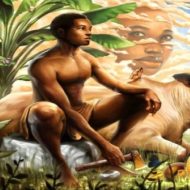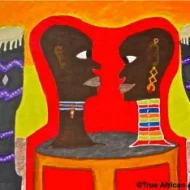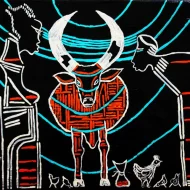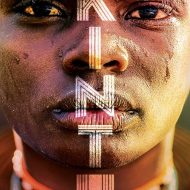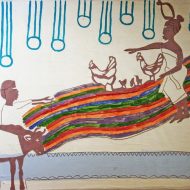Kintu : The First Man
Listen
At a glance
| Description | |
|---|---|
| Origin | Baganda Mythology |
| Classification | Mortals |
| Family Members | Nambi (Wife), Walumbe (Brother) |
| Region | Uganda |
| Associated With | Civilization, Bravery |
Kintu
Introduction
Kintu holds a pivotal role in the creation myth of the Buganda people in Uganda. Recognized as the inaugural inhabitant of the Earth and the initial explorer of the Ugandan plains, he is occasionally equated with divinity or acknowledged as the progenitor responsible for establishing the earliest kingdoms. Kintu’s narrative encapsulates the fundamental aspects of creation, intertwining stories of love, sorrow, and the everlasting essence of humanity. As a revered figure in Baganda mythology, Kintu’s tale stretches beyond temporal boundaries, echoing through the cultural and spiritual core of the Baganda people.
Physical Traits
The physical characteristics of Kintu remain elusive in the mythology, lacking explicit descriptions. Nonetheless, accounts often portray him as a solitary figure, residing with a solitary cow, his sole possession. His sustenance initially derived from the cow’s milk and dung until the sky god, Ggulu, bestowed upon him bananas and millet. Kintu’s appearance eludes a singular depiction; in some renditions, he manifests as a robust individual, his skin mirroring the richness of the earth, with eyes reflecting the vast expanse of the sky. Alternatively, he is depicted as a youthful, agile figure, radiating vibrancy while carrying the wisdom of ages in his gaze. Regardless of the portrayed form, Kintu exudes an undeniable charm that captivates both love and admiration. He embodies the fusion of human vulnerability and divine potential, leaving an indelible mark in the collective memory of the Baganda.
Family
In Baganda mythology, Kintu holds the esteemed position of being the forebearer of the Baganda people, a crucial figure in their ancestral heritage. The myth unfolds with Ggulu, the sky god, selecting Kintu to embark on a divine quest accompanied by his loyal dog to procure the sacred fire. Successful in this celestial mission, Kintu is entrusted with the profound responsibility of assuming the role of the first human ruler, laying the foundation for the royal lineage that would shape the destiny of the Baganda kingdom.
Kintu’s familial ties are intricate, encompassing his marriage to Nambi, the daughter of Ggulu. Their union produced three children, marking the beginning of the Baganda people. Nambi, a celestial being, descends from heaven, carrying with her the promise of life and fertility. This divine pairing establishes Kintu as the patriarch and Nambi as the mother of generations, weaving the intricate fabric of Baganda ancestry.
Among their progeny, Kintu’s sons, Kayima and Kimera, emerge as the inaugural Kabakas (kings) of Buganda, solidifying his lineage as the cornerstone of the kingdom. However, Kintu’s family extends beyond biological connections. He is recognized as the father of all Baganda, symbolizing their shared ancestry and the profound link to the divine that unites them. In this way, Kintu’s legacy reverberates not only through his regal descendants but also through the broader Baganda community, fostering a collective sense of identity and divine connection.
Other names
Kintu is frequently associated with the name Muntu, the legendary figure credited with founding the Gisu and Bukusu tribes. Additionally, he is sometimes revered as God or acknowledged as the father of all people. The name Kintu itself holds profound significance in the Luganda language, translating to “thing,” symbolizing his embodiment of all that exists and all that is possible. Another epithet, “Mpuka,” meaning the king’s drum, underscores the power and authority passed down to his descendants. Various titles, such as “Kintu Nnaggabo” (Kintu the Great) and “Mwebeeta” (the one who brought order), shed light on the diverse roles played by Kintu in shaping the world.
Powers and Abilities
While the mythology does not explicitly outline Kintu’s powers and abilities, he is portrayed as a resilient and sagacious figure. The creation myth subjects Kintu’s humanity to a rigorous test by Ggulu, involving five progressively challenging trials. Despite the escalating difficulty, Kintu emerges triumphant in each trial, aided by an unidentified divine force. Kintu transcends mere mortality; he stands as a conduit between the celestial and earthly realms, possessing remarkable wisdom drawn from the very essence of creation.
Kintu’s intuition is legendary, enabling him to navigate intricate situations and foresee potential challenges. He wields a spear named Mugulu, crafted in divine fires, symbolizing not only his leadership but also his ability to safeguard his people. However, Kintu’s most extraordinary power lies in his capacity for love. His profound affection for Nambi surpasses the boundaries of heaven and earth, leading him to make the ultimate sacrifice by relinquishing his immortality for her sake. This act of profound love echoes throughout Baganda culture, shaping their values surrounding marriage, family, and the willingness to sacrifice for the greater good.
Modern Day Influence
The narrative of Kintu maintains a profound impact on contemporary Buganda culture, standing as the theological, constitutional, and social cornerstone of the kingdom. Taught in schools, the Kintu myth is regarded as the bedrock upon which the Buganda Kingdom is established. Functioning as a crucial reminder of the origins of the Baganda people, Kintu’s story continues to mold their identity and cultural norms.
Beyond the confines of oral tradition, Kintu’s influence permeates various artistic expressions. His visage adorns murals and sculptures, while his tale finds expression in folk songs and poetry. The lineage of the Kabakas of Buganda traces back to Kintu, cementing his pivotal role as the foundation of their authority. In the present day, Kintu remains a wellspring of inspiration for resilience, leadership, and enduring love. His legacy serves as a poignant reminder of the divine essence within humanity, urging us to embrace our responsibilities as custodians of the world.
Related Images
Frequently Asked Questions
What is lorem Ipsum?
I am text block. Click edit button to change this text. Lorem ipsum dolor sit amet, consectetur adipiscing elit. Ut elit tellus, luctus nec ullamcorper mattis, pulvinar dapibus leo.
What is lorem Ipsum?
I am text block. Click edit button to change this text. Lorem ipsum dolor sit amet, consectetur adipiscing elit. Ut elit tellus, luctus nec ullamcorper mattis, pulvinar dapibus leo.
What is lorem Ipsum?
I am text block. Click edit button to change this text. Lorem ipsum dolor sit amet, consectetur adipiscing elit. Ut elit tellus, luctus nec ullamcorper mattis, pulvinar dapibus leo.
What is lorem Ipsum?
I am text block. Click edit button to change this text. Lorem ipsum dolor sit amet, consectetur adipiscing elit. Ut elit tellus, luctus nec ullamcorper mattis, pulvinar dapibus leo.
What is lorem Ipsum?
I am text block. Click edit button to change this text. Lorem ipsum dolor sit amet, consectetur adipiscing elit. Ut elit tellus, luctus nec ullamcorper mattis, pulvinar dapibus leo.

